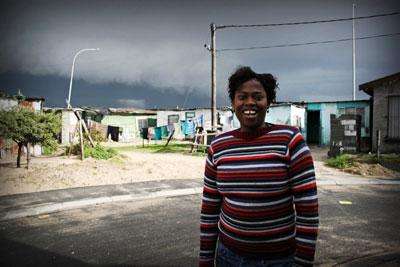December 1, 2009, is World AIDS Day, and we are bringing you snapshots of life with HIV in an area hardest-hit by the disease—Khayelitsha, a sprawling township mired in poverty on the outskirts of Cape Town, South Africa. Watch the videos and meet these HIV patients: a 10-year-old boy, a young woman rejected by her family, a woman failing on her second-line drugs, and a patient who was co-infected with HIV and TB and now helps other patients.
What HIV/AIDS Looks Like Today in South Africa
In the streets of Khayelitsha, a sprawling township mired in poverty on the outskirts of Cape Town, there is a saying, “Living with HIV, dying from TB”. It sums up life in this place, where nearly one in three is HIV-positive and HIV-related infections are the leading cause of death. A staggering 5.5 million people live with HIV/AIDS in South Africa—more than any other country in the world. Despite having the world’s highest number of people receiving antiretroviral (ARV) therapy, about 850,000, there are millions more who cannot access the life-saving drugs they need—either because they are too expensive or simply not available. This leads to more than 350,000 HIV-related deaths each year in South Africa.
Here it is painfully clear that the global HIV/AIDS emergency is not over, while 33 million people in the world today still live with the disease that wipes out 2 million lives each year.
HIV attacks the immune system leaving those infected vulnerable to infectious diseases like TB, which spreads easily in Khayelitsha’s poor living conditions and dense population.
MSF Treats HIV Patients in Khayelitsha
Since pioneering HIV/AIDS treatment and care in Khayelitsha 10 years ago, Médecins Sans Frontières/Doctors Without Borders (MSF) has in collaboration with South African Department of Health put over 13,000 patients on ARVs and developed an effective way to fight the battle against the deadly dual epidemic. By integrating HIV and TB treatments at the Ubuntu clinic, patients receive higher quality care and doctors are better able to manage their conditions.
The Ubuntu clinic is a success story from the frontlines of HIV care, treating more than 6,000 HIV and TB patients each year, but more must be done—continued funding must be secured, and newer, more affordable drugs are desperately needed.
Internationally, donor governments and financers are pulling back from funding commitments for HIV treatment in the developing world, where two thirds of the world’s HIV positive population live. Time is running out for the 6 million people in need of treatment. Most people living with HIV/ AIDS will die within three years if they are denied care.




